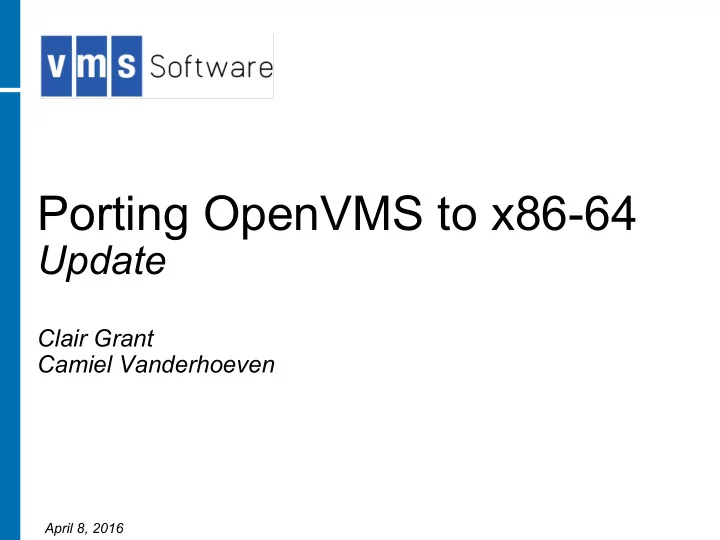

Porting OpenVMS to x86-64 Update Clair Grant Camiel Vanderhoeven April 8, 2016
Porting OpenVMS to x86-64 Update This information contains forward looking statements and is provided solely for your convenience. While the information herein is based on our current best estimates, such information is subject to change without notice.
Porting Play Book (The Plan) Chapter 1 – Executable Images • Definition : Register Mapping, Calling Standard extensions • Creation: Compilers, Assembler • Action: LIBRARIAN, LINKER, INSTALL, Image Activator • Analysis: SDA, DEBUG/XDELTA, ANALYZE IMAGE, ANALYZE OBJECT Chapter 2 – Architecture-Specific Needs (a.k.a. “The 5%”) • Booting • Interrupts, Exceptions • Memory Management: protection types, access modes, address space, etc. • Atomic Instructions • Floating Point • Special needs for code in assembler (e.g. VAX QUEUE instruction emulation) Chapter 3 – Compiling and Linking Everything Else (a.k.a. “The 95%”) • Large task but mostly mechanical • Flush out any remaining ‘inter-routine linkage’ problems
VMS Itanium Compilers and Image Building C BLISS FORTRAN BASIC GEM .exe .obj LINKER COBOL Assembler Interface PASCAL Inner Workings of GEM MACRO 1. Get source code and command line directives 2. Create Intermediate representation (IR) C++ 3. Interpret IR Intel 4. Generate target object file Ada AdaCore
Future VMS Compiler Strategy C BLISS FORTRAN LLVM GEM BASIC LLVM .obj* LINKER .exe* Translator IR IR Standard Standard Assembler Standard * = ELF just like Itanium COBOL SS Interface Interface Interface Interface PASCAL MACRO C++ clang Ada ??? § Continue with current GEM-based frontends § Use open source LLVM for backend code generation § Create internal representation (IR) translator § LLVM targets x86, ARM, PowerPC, MIPS, SPARC, and more
Executable Images • Compilers − LLVM • Compiled on VMS Itanium COMPLETE! • GEM IR to LLVM IR translator UNDERWAY − Compile with DEC C/LLVM on OpenVMS Itanium, link and run on Linux − XMACRO • Register mapping COMPLETE! • Connect XMACRO to LLVM assembler interface UNDERWAY • Developing VAX to x86 instruction mapping UNDERWAY • Developing VAX to x86 addressing mapping UNDERWAY • Calling Standard UNDERWAY − Based on AMD64 Application Binary Interface − Like Itanium - ELF, DWARF, unwind tables
Executable Images (continued) • LINKER − Initial outline of work COMPLETED! − Relocations and fixups – minimal work − Calculate virtual address space – some work − Pass 2 – most of the change is here − Writing executable/shareable images and symbol table files – small change • LIBRARIAN - minimal work • INSTALL, Loader, Image Activator − Relocations/fixups – small change − Share most crucial pieces of code • Static/dynamic translator
“First Boot” (with Cross Tools) Images C LLVM LLVM GEM Translator BLISS XMACRO BLISS C XMACRO Calling Standard Calling Standard Linker LINKER x86ASM
Analysis Tools: Laying the Foundation • x86 Instruction Set Decoder COMPLETE! − 640 opcodes in total − Test ‘byte streams’ created for each instruction; developed/verified on linux − Used by SDA, DELTA/XDELTA, DEBUG, SCD, ANALYZE/OBJECT • Evaluate LIB$IPF_CALLING_STANDARD routines; used by “stack walkers” and others − Invocation Context (current, previous) − Registers − Unwind data
Architecture-Specific Needs • Boot Path • Memory Management • Use of Assembler
Boot Path • VMS_LOADER.EFI − Using UEFI 2.3 toolkit – Itanium and x86 COMPLETE ! − Eliminate VMS boot drivers, use UEFI device drivers and memory disk COMPLETE ! − New crash dump strategy and implementation TESTING − Eliminate HPE-specific firmware interfaces COMPLETE! − Create • memory descriptors COMPLETE! • Interrupt Vector Table (IVT) PROTOTYPING • CPU enumeration list PROTOTYPING • x86-specific structures PROTOTYPING − Make better use of ACPI interface and tables PROTOTYPING − Create a graphical boot manager PROTOTYPING − X86 Machine check handling PROTOTYPING • IPB & SYSBOOT evaluating
Memory Management • Initial investigation COMPLETE! • Factoids: − Four levels of page tables PROTOTYPING − VMS will run in two hardware modes PROTOTYPING − Page protection requires page tables per mode − No PROBE instruction; look it up in page tables COMPLETE! − Page sizes – 4KB, 2MB, 1GB
Running in Two Processor Modes • x86 has four modes (rings) 0, 1, 2, 3. • They do not provide the strict hierarchy of memory access protection expected by VMS. • Example: No way to allow kernel write and prevent exec write. • VMS will run in two hardware processor modes – privileged (0) and unprivileged (3). • Supervisor (1) and Exec (2) memory protections will be implemented in software. • Currently prototyping and testing two-mode operation on Itanium.
SWIS & Friends • Many related architecture-specific details in one place: Software Interrupt Services (SWIS), Exception, AST Delivery… • Hides the details from the rest of VMS − Many aspects of the Calling Standard − Entering a more privileged mode − Interrupt handling • Software Interrupts • ASTs • External Interrupts − Saved state − Exception frames − Context switching − System service calling
SWIS & Friends • Conceptually architecture independent – the code is specific for each platform but it performs the same logical functions • The largest single piece of concentrated assembler code apart from IMATHRTL • Design finished, currently under review
Use of Assembler • Evaluate Itanium assembler code COMPLETE! 1. Eliminate what is not needed 2. Replace with C equivalents if possible 3. Convert to x86 assembler • Priority: Follow the boot path • If better performance is needed then use assembler – difficult to predict, just let it happen and react
Virtual Machines • Development/test environments: − KVM / CentOS − XEN − VirtualBox − VMware ESXi 6.0 − Vmware Workstation 12 − VMware Fusion • Used so far for − Debugging VMS_LOADER.EFI − Prototyping and experimenting • Paravirtualized storage drivers implementing − Starting point: HPVM driver • Paravirtualized network drivers
Various − VAX/Alpha/IA64 conditionalized code UNDERWAY − Non-standard calling sequences INVESTIGATING − Evaluated Ada code COMPLETE! • Plan to rewrite ACME in C • Plan to rewrite Security_Server in C++
For more information, please contact us at: RnD@vmssoftware.com VMS Software, Inc. • 580 Main Street • Bolton MA 01740 • +1 978 451 0110
Recommend
More recommend